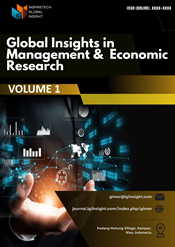Impact of Liquidity Ratio and Solvency Ratio on the Profitability Ratio in PT. Indofood Sukses Makmur
DOI:
https://doi.org/10.53905/Gimer.v1i03.18Keywords:
Current Ratio, Debt to Asset Ratio, Return on Assets, Financial Performance, Liquidity Ratio, Solvency Ratio, Profitability RatioAbstract
Introduction: Financial performance is a critical indicator of corporate health and operational efficiency. PT. Indofood Sukses Makmur, Tbk., as one of Indonesia's leading food processing companies, has exhibited fluctuations in its financial ratios during 2019-2023, necessitating an empirical investigation into the relationships between liquidity, solvency, and profitability metrics.
Purpose of the Study: This research aims to examine the impact of liquidity ratio (Current Ratio) and solvency ratio (Debt to Asset Ratio) on profitability ratio (Return on Assets) at PT. Indofood Sukses Makmur, Tbk. during the period 2019-2023, both partially and simultaneously.
Materials and Methods: This quantitative study employed secondary data from audited financial statements obtained from the Indonesia Stock Exchange. Multiple linear regression analysis was conducted using SPSS version 23, with classical assumption tests including normality, multicollinearity, and heteroscedasticity tests. The sample consisted of annual financial data over five consecutive years (2019-2023).
Results: The partial test (t-test) revealed that Current Ratio significantly and positively influences ROA (t-value = 3.409 > t-table = 2.353, p = 0.032). Similarly, Debt to Asset Ratio demonstrates a significant positive effect on ROA (t-value = 3.578 > t-table = 2.353, p = 0.042). The simultaneous test (F-test) confirmed that both ratios collectively impact ROA (F-value = 4.223 > F-table = 19.30, p = 0.217). The adjusted R² value of 0.635 indicates that 63.5% of ROA variance is explained by the independent variables.
Conclusions: Both liquidity and solvency ratios significantly influence profitability at PT. Indofood Sukses Makmur, Tbk. Enhanced liquidity management and optimal capital structure contribute positively to asset utilization efficiency and profit generation. These findings provide empirical evidence for financial decision-making and strategic planning in the food manufacturing sector.
References
Ai, H., Frank, M. Z., & Sanati, A. (2020). The Trade-off Theory of Corporate Capital Structure. SSRN Electronic Journal. https://doi.org/10.2139/ssrn.3595492
Alathamneh, M. S., Obeidat, M. I. S., Al-Momani, M., Almomani, T. M., & Darkel, N. (2024). Towards Understanding the Firm Specific Determinants of Corporate Financial Flexibility. Research Square (Research Square). https://doi.org/10.21203/rs.3.rs-4952263/v1
Amoa‐Gyarteng, K. (2021). Corporate Financial Distress: The Impact of Profitability, Liquidity, Asset Productivity, Activity and Solvency. Journal of Accounting Business and Management (JABM), 28(2), 104. https://doi.org/10.31966/jabminternational.v28i2.447
Batrancea, L. M. (2021). The Influence of Liquidity and Solvency on Performance within the Healthcare Industry: Evidence from Publicly Listed Companies. Mathematics, 9(18), 2231. https://doi.org/10.3390/math9182231
Daryanto, W. M., Samidi, S., & Siregar, D. J. (2018). The impact of financial liquidity and leverage on financial performance: Evidence from property and real estate enterprises in Indonesia. Management Science Letters, 1345. https://doi.org/10.5267/j.msl.2018.9.005
Dera, A., Sutrisno, S., & Febrianti, R. (2025). The Effect of Current Ratio, Price to Book Value, and Debt to Equity Ratio on Return on Assets (in Food and Beverage Companies Listed on the Indonesia Stock Exchange in 2021-2023). Ilmu Ekonomi Manajemen Dan Akuntansi, 6(2), 102. https://doi.org/10.37012/ileka.v6i2.2969
Dženopoljac, V., Ognjanović, J., Dženopoljac, A., & Kraus, S. (2023). Exploring the impact of employer brand attributes on financial performance: an intellectual capital perspective. Journal of Intellectual Capital, 24(7), 31. https://doi.org/10.1108/jic-05-2023-0112
Fahmi, I. (2017). Analisis kinerja keuangan (6th ed.). Alfabeta.
Farah, I., Amin, C., & Pramudianto, P. (2021). The Effect of Debt To Asset Ratio, Long Term Debt To Equity Ratio and Time Interest Earned Ratio on Profitability. Bina Bangsa International Journal Of Business And Management, 1(1), 68. https://doi.org/10.46306/bbijbm.v1i1.8
Geeta, Dr. M., & Nagasivanand, Dr. C. (2021). Financial Planning through the Liquidity Ratios for HDFC and SBI Banks. Revista Gestão Inovação e Tecnologias, 11(4), 2616. https://doi.org/10.47059/revistageintec.v11i4.2304
Hasibuan, S. J., Ramadhani, L., & Sagala, L. G. (2024). Pengaruh rasio keuangan terhadap kinerja keuangan PT. Indofood Sukses Makmur Tbk yang terdaftar di Bursa Efek Indonesia tahun 2016-2020.
Hedge Fund Liquidity Management. (2017). SSRN Electronic Journal. https://doi.org/10.2139/ssrn.3033930
Hery. (2015). Akuntansi aset, liabilitas, dan ekuitas. Grasindo.
Hery. (2017). Kajian riset akuntansi: Mengulas berbagai hasil penelitian terkini dalam bidang akuntansi dan keuangan. Grasindo.
Indonesia Stock Exchange. (2023). PT. Indofood Sukses Makmur Tbk financial statements 2019-2023. Retrieved from Ikatan Akuntan Indonesia. (2019). Standar akuntansi keuangan. Salemba Empat.
Jaafar, S. B., Salleh, A., & Hamzah, H. (2021). Financial ratio analysis as a device for predicting financial distress. SSRN Electronic Journal. https://doi.org/10.2139/ssrn.3818116
Jensen, M. C., & Meckling, W. H. (1976). Theory of the firm: Managerial behavior, agency costs and ownership structure. Journal of Financial Economics, 3(4), 305. https://doi.org/10.1016/0304-405x(76)90026-x
Kariyawasam, H. N. (2019). Analysing the Impact of Financial Ratios on a Company’s Financial Performance. International Journal of Management Excellence, 13(1), 1898. https://doi.org/10.17722/ijme.v13i1.1093
Kartika, A., Hikmah, A. A., Damayanti, A., & Najib, M. T. A. (2024). Analisis Rasio Terhadap Laporan Keuangan Pada PT Indofood Sukses Makmur Tbk. JEMeS - Jurnal Ekonomi Manajemen Dan Sosial, 7(2), 67. https://doi.org/10.56071/jemes.v7i2.891
Kasmir. (2021). Analisis laporan keuangan (13th ed.). Rajawali Pers.
Kasuma, A. B. H., & Rabbani, R. R. (2024). Analysis of the Implementation of Good Corporate Governance in Food Companies: PT. Indofood Success Makmur. International Journal of Applied and Advanced Multidisciplinary Research, 2(3), 163. https://doi.org/10.59890/ijaamr.v2i3.1493
Khair, H., Bismala, L., Arianty, N., & Pratami, L. (2016). Manajemen strategi. UMSU Press.
Kusuma, N. P. N. (2024). Prediksi Harga Saham Blue Chip Pada Indeks Idx30 Menggunakan Algoritma Recurrent Neural Network (RNN). Ekonomi & Bisnis, 23(1), 90. https://doi.org/10.32722/eb.v23i1.6609
Margaretha, F. (2018). Manajemen keuangan untuk manajer non keuangan (2nd ed.). Erlangga.
Okpiabhele, E., & Tafamel, A. E. (2020). Liquidity Management and Profitability of Consumer and Industrial Goods Companies in Nigeria. The International Journal of Business & Management, 8(6). https://doi.org/10.24940/theijbm/2020/v8/i6/bm2006-019
Rahman, A. A. A. (2017). The Relationship between Solvency Ratios and Profitability Ratios: Analytical Study in Food Industrial Companies listed in Amman Bursa. DergiPark (Istanbul University). https://dergipark.org.tr/tr/pub/ijefi/issue/32035/354446
Ramadhan, R. (2025). Profitability and Liquidity Analysis to Assess Financial Performance at PT. Indofood Sukses Makmur, Tbk. 2022-2023. SSRN Electronic Journal. https://doi.org/10.2139/ssrn.5126504
Rambe, F. M., Gunawan, A., Julita, Parlindungan, R., Gultom, D. K., & Wahyuni, S. F. (2015). Manajemen keuangan (4th ed.). Citapustaka Media.
Ramdaniansyah, M. R. (2020). Pengaruh likuiditas dan solvabilitas terhadap profitabilitas pada PT. Indofood CBP Sukses Makmur Tbk yang terdaftar di Bursa Efek Indonesia. Jurnal Aktiva: Riset Akuntansi dan Keuangan, 2(1), 1-7
Ripaluddin, R., Pasulu, M., & Taufiq, A. (2023). The Effect of Liquidity and Leverage on Firm Value Through Profitability at PT. Indofood Sukses Makmur Tbk. Jurnal Economic Resource, 6(1), 47. https://doi.org/10.57178/jer.v6i1.532
Rudianto. (2015). Akuntansi manajemen: Informasi untuk pengambilan keputusan strategis. Erlangga.
Samryn, L. M. (2015). Akuntansi manajemen: Informasi biaya untuk mengendalikan aktivitas operasi dan investasi (2nd ed.). Kencana.
Setyasari, U. E. (2022). Pengaruh rasio likuiditas dan rasio solvabilitas terhadap rasio profitabilitas di PT Indofood Sukses Makmur Tbk periode 2011-2021. JRAK (Jurnal Riset Akuntansi dan Bisnis), 8(1), 160-167.
Shahnia, C., Purnamasari, E. D., Hakim, L., & Endri, E. (2020). Determinant of profitability: Evidence from trading, service and investment companies in Indonesia. Accounting, 787. https://doi.org/10.5267/j.ac.2020.6.004
Sihombing, J. D., & Pratomo, L. A. (2024). INDOFOOD’S GLOBAL STRATEGY: BALANCING INNOVATION, SUSTAINABILITY, AND MARKET EXPANSION. Jurnal Ekonomi Trisakti, 4(2), 405. https://doi.org/10.25105/v4i2.20723
Susanto, J. G. Y., & Handoyo, S. E. (2023). Pengaruh likuiditas, profitabilitas, solvabilitas, dan aktivitas terhadap financial distress pada perusahaan yang terdaftar di Bursa Efek Indonesia periode 2020-2021. Jurnal Manajemen Bisnis Dan Kewirausahaan, 7(5), 1139. https://doi.org/10.24912/jmbk.v7i5.26513
Suwardi, S., Wibowo, K. A., & Annisa, A. Y. (2023). How to Achieve Profit Growth by Optimizing Operational Resources Based on Total Efficiency in Food and Beverage Companies in Indonesia. International Journal of Scientific Research and Management (IJSRM), 11(10), 5216. https://doi.org/10.18535/ijsrm/v11i10.em04
Syahputri, A., Putra, H. S., Julyanthry, J., Sari, E. P., & Putri, D. E. (2022). Effect of Current Ratio and Debt to Asset Ratio on Return On Asset Moderated by Firm Size. International Journal of Economics Business and Accounting Research (IJEBAR), 6(1), 191. https://doi.org/10.29040/ijebar.v6i1.4418
Vijayalakshmi, S., & Arpanaa, S. (2021). Cash Conversion Cycle of food and beverage Product industry. International Research Journal on Advanced Science Hub, 3, 37. https://doi.org/10.47392/irjash.2021.162
Viranda, E. Y., Antonio, T., & Arman, A. (2023). The Effect of Liquidity Ratios, Profitability Ratios, and Solvency to Value Ratio Company Studies on Sector Companies Consumer Goods Industry Listed on IDX Period 2018-2021. International Journal of Review Management Business and Entrepreneurship (RMBE), 3(1), 200. https://doi.org/10.37715/rmbe.v3i1.4306
Wardiyah, M. L. (2017). Analisis laporan keuangan. Pustaka Setia.
Published
Issue
Section
Categories
License
Copyright (c) 2025 Trisnawati Manik, Laily Ramadhani, Lapiti Gokmatua Sagala (Author)

This work is licensed under a Creative Commons Attribution-ShareAlike 4.0 International License.






